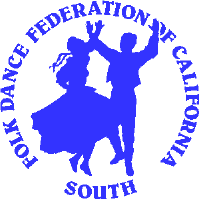
|
Folk Dance Federation of California, South, Inc.
|
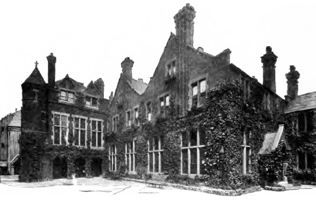
|
CLICK AN IMAGE TO ENLARGE
[
Home |
About |
Albums |
Articles |
Associates |
Calendar |
Camps |
Clubs |
Dances |
Donate |
History |
Insurance |
Links |
|
Membership |
Officers |
Photographs |
Publications |
Resources |
Scene |
Statewide |
Syllabi |
Teachers |
Videos
]
Click a green link!
Click CAMPS (Closed), for a look at closed folk dance camps in California and Colorado.
Click COFFEEHOUSES (Mostly Closed), for a look at mostly closed folk dance centers in Southern California.
Click PERFORMING GROUPS (Mostly Closed), for a look at mostly closed folk dance performing groups in Southern California.
Click FORMER CLUBS (Closed), for a list of closed folk dance clubs in Southern California.
 Folk dancers come in assorted shapes, heritages, sizes, and occupations – from cooks to teachers, from bus drivers to attorneys, from elementary school children to grandmas and grandpas. Dances vary in difficulty from simple walking steps to the most intricate floor patterns. Singles are delighted to find that there are many non-partner dances and couples enjoy learning new steps together. Folk dancing today is a major recreational activity that is shared with millions of people around the world. Best of all, folk dancing is fun, sociable, and great exercise. Since the very beginning, people have been dancing – in the fields, in the home, in the courts of royalty, in the churches – just about everywhere. Wherever people felt the need to express themselves in rhythmic movement, there was folk dance . . . the sheer joy of getting up and moving to song and music. Within the last few generations, the United States has become a repository of the world's folk culture and folk dances.
Folk dancers come in assorted shapes, heritages, sizes, and occupations – from cooks to teachers, from bus drivers to attorneys, from elementary school children to grandmas and grandpas. Dances vary in difficulty from simple walking steps to the most intricate floor patterns. Singles are delighted to find that there are many non-partner dances and couples enjoy learning new steps together. Folk dancing today is a major recreational activity that is shared with millions of people around the world. Best of all, folk dancing is fun, sociable, and great exercise. Since the very beginning, people have been dancing – in the fields, in the home, in the courts of royalty, in the churches – just about everywhere. Wherever people felt the need to express themselves in rhythmic movement, there was folk dance . . . the sheer joy of getting up and moving to song and music. Within the last few generations, the United States has become a repository of the world's folk culture and folk dances.
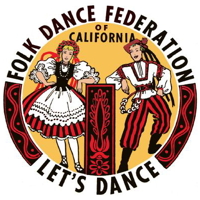 In order to tell the story of the Folk Dance Federation of California, South, we have to go back in time – long before the date of its birth. Before the Federation, South, there was a sort of international folk dance "Dreamtime" from which everything else started.
In order to tell the story of the Folk Dance Federation of California, South, we have to go back in time – long before the date of its birth. Before the Federation, South, there was a sort of international folk dance "Dreamtime" from which everything else started.
Prior to the 1930s, international folk dancing as we now know it in California did not exist. Even among the ethnic communities, dancing was very limited. Many ethnic groups, fleeing the turmoils that beset them in their homelands, did not have strong interests in preserving their cultures. In fact, many came to the United States to forget. There was no point or reason to preserve reminders of pain and horror, and the young immigrants were interested only in the American way of life. The newcomers adapted readily and rapidly and, except for a few diehards, the older immigrants were satisified to ignore their traditions. Not that there were no ethnic cultural activities at all, for there were. But as a rule, outsiders were not welcomed at the gatherings and so the general American public and other national groups were rarely able to observe or participate in ethnic events.
At the end of this "Dreamtime," The Folk Dance Federation of California, Inc. was formed in Northern California. Were it not for the Federation in what Southern Californians called the "North," there would probably be no "South" today, and without the "Dreamtime," probably no "North," either. That folk dance pre-history, from which all originated, is hazy, indistinct, scarce on dates and facts, but meaningful to the folk dance movement. After the Federation, North, came the Federation's "Southern Section" (or "Baby Brother"), which grew and finally struck out on its own as the Folk Dance Federation of California, South, Inc.

In the mid-1930s, San Franciscans who were interested in Scandinavian folk arts were given an opportunity to further their knowledge of things Swedish when "Mama" Gavander opened her home in Pacific Heights. With her own personal charm, she welcomed outsiders who wanted to participate in learning the music, dance, and arts and crafts of Sweden. One of these visitors was Mr. Song Chang, an American of Chinese descent, who had visited Europe a few years earlier and had become interested in folk dance in the areas where it was still alive and well. There was something in the warm and friendly camaraderie among the visitors at the Gravander sessions that caused Chang to feel that this was a situation that should become more common. Somebody, he felt, should develop this Swedish experience into a more international scale. At the time, a few folk dances were taught in some schools to a small degree. These simple dances were gleaned from traditional books, such as the Burchenal series and the Country Dance Society volumes. There was no one teaching international dance to the public.
Thus it was that in 1938, "Chang's," the premier San Francisco group, came into being and eventually became known as Chang's International Folk Dancers. Mr. Chang and other early members began to teach dances of many nations to the general public. Ominous clouds were beginning to appear on the European horizon and a greater interest in things foreign began to develop in America, especially in ever-cosmopolitan San Francisco and the California Bay Area. Chang's and other San Francisco area folk dancers were particularly excited when the group participated in the International Folk Dance Exhibition at the San Francisco World's Fair and saw much more interantional folk dancing, colorful costumes, and live music than they had ever seen before.
Soon after this, several new groups in the Bay Area began to form. These groups were eager to learn more about folk dance and its related arts. It looked like so much fun – and it was! Some groups met in schools, some in playgrounds, others in homes – anywhere there was room for a few people to move around and an electric outlet to plug in a phonograph. As these groups grew in size and numbers, they began to exchange dances they had learned. Somewhere along the line, the idea of having a gathering or festival blossomed. When the dancers from various groups began to dance together, however, it became evident that some sort of system was necessary to bring about some order so that all clubs would learn dances the same way to the same music and follow the same floor patterns. While most of the clubs' teachers in those days gave readily of their time and expertise, there was still a unifying force needed to coalesce the movement. By early 1942, that force came into being.
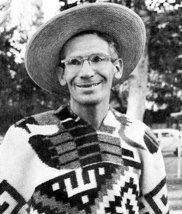 At the May 1942 festival in Lodi, California, a group of folkdance leaders, chaired by Henry "Buzz" Glass, gathered to finalize details of a program that they had been collectively and individually working on for some time. It was agreed that an association of clubs and dancers was in order. Some six weeks later, after several interim meetings, the Folk Dance Federation came into official existence at the Golden Gate Park Conservatory festival. It's charter was simple but concise; it selected a slate of seven officers and its future plans were unlimited.
At the May 1942 festival in Lodi, California, a group of folkdance leaders, chaired by Henry "Buzz" Glass, gathered to finalize details of a program that they had been collectively and individually working on for some time. It was agreed that an association of clubs and dancers was in order. Some six weeks later, after several interim meetings, the Folk Dance Federation came into official existence at the Golden Gate Park Conservatory festival. It's charter was simple but concise; it selected a slate of seven officers and its future plans were unlimited.
There were giants on the earth in those days – the folk dance earth, that is. The roster of names of the leaders of the Federation and its clubs inclues all the legendary people with whom early international folk dancing in California is associated. All were filled with tremendous ideas and equally tremendous amounts of enthusiasm and vitality. From those qualities grew such things as Teacher's Institutes; Research and Standardization Programs, whereby all dances were throroughly studied and notated so dancers could all learn alike; a two-page newsletter that quickly grew into the nationally-known Let's Dance magazine; a publications department that developed a series of dance instruction manuals called Dances from Near and Far; and, a few years later in 1948, the world famous College of the Pacific Folk Dance Camp (later to become known as the Stockton Folk Dance Camp).
With the backing of the Federation as an organizing base and mentor, folk and square dance clubs began to multiply like rabbits. By 1946, there were close to 100 groups affiliated with the organization, north of the Tehachapi Mountains. The Federation and its clubs enjoyed a good relationship with the press and the general public found dancers, their colorful costumes, and especially their bubbling enthusiasm, something pleasureable to watch. Much of this rubbed off on these spectators and they also became converts. Club leaders and members, as well as the Federation officers and publicity chairpeople, worked hard to promote their passtime.
Meanwhile, in Southern California, the folk dance picture was running just about four years behind the San Francisco area. The first clubs began to appear about 1942. Just as did those earlier in Northern California, they started to meet together, have parties, and exchange dances and information. the American Music Company on South Broadway in Los Angeles was a source of some dance records, but where records were unobtainable, some of the musically talented members of clubs would pound out homemade disks on piano or accordion, then dub and exchange them.
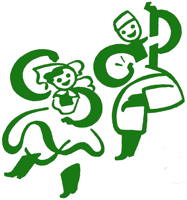 News began to filter southward about the fun that was being had at the festivals in the North and of the organization that helped unify the clubs. By the summer of 1945, there were a few independent folk dance groups functioning throughout Southern California. Some were not even aware of one another's existence. With World War II now over and gas rationing no longer restricting travel, Southland dancers betan to hie north to see for themselves. Northern leaders visiting in Southern California found that there were places to dance in the South, also. When the Federation-minded Northerners waxed enthusiastic about their organization, the Southern dancers decided that a federation also was needed in the South.
News began to filter southward about the fun that was being had at the festivals in the North and of the organization that helped unify the clubs. By the summer of 1945, there were a few independent folk dance groups functioning throughout Southern California. Some were not even aware of one another's existence. With World War II now over and gas rationing no longer restricting travel, Southland dancers betan to hie north to see for themselves. Northern leaders visiting in Southern California found that there were places to dance in the South, also. When the Federation-minded Northerners waxed enthusiastic about their organization, the Southern dancers decided that a federation also was needed in the South.
Foremost among these Southland leaders was Katherine Jett of the Westwood Co-op Folk Dancers, who started the idea of a federation of southern clubs moving. She contacted Walter Grothe, the Federation vice president, and others contacted other San Francisco leaders. Lucille Czarnowski, president of the Federation, convened its officers and drafted a letter to the Southern leaders, offering to assist in the formation of a group of clubs that would be affiliated with the Federation. A temporary steering committee was formed. All southern clubs were invited to send representatives to the Griffith Park Festival, the first Southern California folk dance festival, held in the heart of Los Angeles on March 10, 1946, for a second steering committee meeting. Eleven groups were represented, including the Los Angeles Recreational Co-op, Hollywood Folk Dance Center, Hollywood Peasants, Westwood Co-op Folk Dancers, West Los Angeles Playground, Silverlake Dance Group, LaVerne College, Pasadena Folk Dance Co-op, East Los Angeles Folk Dance Co-op, Jarabe Club, and Whittier Folk Dance Fellowship.
Walter Grothe and Henry Koopman, the Historian and soon-to-become editor of Let's Dance magazine, flew down to sit in at the organizational meeting, advise as necessary, and explain the Federation's bylaws. With an already successful charter for an example, there were few problems to worry about. A resolution was passed to form the Southern Section fo the Folk Dance Federation of California, pledged to maintain close cooperation with the North. It was at this meeting that the representatives agreed to meet in two months and hold a festival to which all dancers from both ends of the state would be invited – a Statewide Festival. The historic day and location selected were May 11, 1946, and the town of Ojai, nestled in the Ojai Valley east of Santa Barbara. Much has been told and retold of this famous festival over the years in the pages of Folk Dance Scene and Let's Dance magazines. Folk dancers from all over the state converged on the town; traffic was diverted, the main street was roped off for dancing, and the entire community festively decorated the town. More than 500 dancers and 3,000 spectators took part in the six hours of continuous dancing.
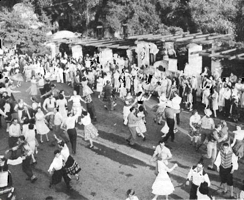 Elected just after the Ojai Festival were the first officers of the Southern Section: Allen Pelton, president and member of the Pasadena Folk Dance Co-op; Ray Shaw, vice president and a noted square dance caller and member of various square and folk dance clubs, including the Hollywood Peasants; Virginia Anderson, corresponding secretary and a member of the Westwood Co-op Folk Dancers; and Katherine Jett, recording secretary, also a member of the Westwood Co-op Folk Dancers; Thais McDonald, historian and member of the Los Angeles Recreational Co-op; Stanley Minton, treasurer and member of the Hollywood Folk Dance Center; and Paul Erfer, director of extension-publicity and also a member of the Hollywood Folk Dance Center.
Elected just after the Ojai Festival were the first officers of the Southern Section: Allen Pelton, president and member of the Pasadena Folk Dance Co-op; Ray Shaw, vice president and a noted square dance caller and member of various square and folk dance clubs, including the Hollywood Peasants; Virginia Anderson, corresponding secretary and a member of the Westwood Co-op Folk Dancers; and Katherine Jett, recording secretary, also a member of the Westwood Co-op Folk Dancers; Thais McDonald, historian and member of the Los Angeles Recreational Co-op; Stanley Minton, treasurer and member of the Hollywood Folk Dance Center; and Paul Erfer, director of extension-publicity and also a member of the Hollywood Folk Dance Center.
Almost immediately, membership in the Southern Section began to mushroom. Within a year, there were over 30 folk and square dance groups affiliated, as well as several ethnic groups, including those from the Philippine, Polish, Swedish, and Mexican communities. Important nationally-known dance leaders visited groups in the Southland enroute to or from the North, including such notables as Dr. Lloyd Shaw, Elizabeth Burchenal, Mary Ann Herman, and Vytautas Beliajus. Teachers' Institutes were held about every three months and, of course, where would one be without an official festival each month? In addition to these regular festivals, there were regional festivals held in towns large and small from Santa Barbara to China Lake, Holtville to San Diego.
There seemed to be no stopping the growth of the Federation, folk dancing, and square dancing until late 1948, when an international incident shouldn't, but did, bring things to a sudden halt. It was the Russian intervention in Czechoslovakia. A motion presented by a group of Federation leaders that would require all folk dance clubs in the Southern Section of the Federation to swear a loyalty oath to the United States in order to maintain membership. Of course, by extension, this meant a loyalty oath from the individual members of the clubs. The result was a severe fracturing of the organization. By the time the measure was eventually defeated, many clubs had already dropped out, including all of the square dance clubs, who formed their own association in 1950.
 The 1950s to 1970s: A Separate Federation
The 1950s to 1970s: A Separate Federation
 The division between international folk dancing and American squares caused some misunderstanding for a time – particularly when a few short-sighted leaders tried to brand all dances with a European origin as "foreign" and to promote "squares and rounds" as the only dances Americans should do. This attitude had soon lost ground as dancers learned that American squares stem from dances brought over from Europe and some "rounds" are essentially European dances with the names changed. The disharmony among many individuals and former friends continued long after the division. Fortunately, wise heads on both sides managed to get together and put the Southern Section back on its feet, almost as good as ever.
The division between international folk dancing and American squares caused some misunderstanding for a time – particularly when a few short-sighted leaders tried to brand all dances with a European origin as "foreign" and to promote "squares and rounds" as the only dances Americans should do. This attitude had soon lost ground as dancers learned that American squares stem from dances brought over from Europe and some "rounds" are essentially European dances with the names changed. The disharmony among many individuals and former friends continued long after the division. Fortunately, wise heads on both sides managed to get together and put the Southern Section back on its feet, almost as good as ever.
The Southern Section finally became its own entity when it formally incorporated and became the Folk Dance Federation of California, South, Inc. The Southern Federation and the Northern Federation were to keep close ties, however, conducting their annual Statewide Folk Dance Festival, alternating locations each from north to south each year. Each of the two federations also continued relations by forming North-South Coordinating Committee. Each year's Statewide festival hosts an Installation Brunch where officers of both the North and South are inaugurated, and a Past Presidents' Party honoring presidents of the North and South who have given their services to folk dancing in previous years.
The basic purposes of the Federation, South, had not changed since its early inception: a mechanism for sharing information about what is happening and where, the coordination of dates of events, the introduction of new material, the sponsorship of special events, and the offer of scholarships to worthy and deserving individuals to participate in the learning and teaching processes.
The introduction of Federation-sponsored insurance for member clubs helped to keep many groups viable who could otherwise not afford the insurance payments.
 The 1980s: The Technology Years
The 1980s: The Technology Years
 By the 1980s, Federation officers and committees began to make use of new equipment and techniques to improve the quality or reduce the labor involved in operational tasks. Festival programs were being pre-recorded on cassette tapes, easier to handle and lighter to carry than vinyl recordings. The calendar, Council meeting minutes, bylaws, and standing rules began to be produced on word processors, virtually retiring the old mimeograph machines. Translating dance steps and styling into words, always a difficult and frustrating task, became easier with the purchase of videotape equipment, which could also be used to resolve later disputes on how a dance was actually taught by the master instructor.
By the 1980s, Federation officers and committees began to make use of new equipment and techniques to improve the quality or reduce the labor involved in operational tasks. Festival programs were being pre-recorded on cassette tapes, easier to handle and lighter to carry than vinyl recordings. The calendar, Council meeting minutes, bylaws, and standing rules began to be produced on word processors, virtually retiring the old mimeograph machines. Translating dance steps and styling into words, always a difficult and frustrating task, became easier with the purchase of videotape equipment, which could also be used to resolve later disputes on how a dance was actually taught by the master instructor.
Folk dancing had traditionally been one of the least expensive forms of recreation. Inflation more than doubled prices of dance shoes, records, tapes, and sound equipment, the basic paraphernalia of folk dancing. In addition, postage, printing, and phone costs continued to rise. More significant, possibly, was losing the public facilities where dances could be held for free. Middle-sized clubs began to struggle to keep solvent, and marginally small clubs found they could no longer survive. Operating expenses of both groups and the Federation began to have to be looked at, priorities set, and cut-backs made, unless more money was raised to pay for the hobby. Even the Federation began to lose the ability to plan major events unless they were guaranteed to draw crowds large enough to cover expenses. Traveling expenses to Council meetings became major obstacles to the once-a-month sponsored festivals where Council meetings were being held, and Federation officers and members of local groups began to recognize that attendance at festivals would be mostly by those who lived nearby.
A major setback for the Federation was the closing of its major folk dance camp, the San Diego State College Folk Dance Conference (which had been formed after a move from the University of California at Santa Barbara campus in Goleta) because of escalating costs and dwindling attendance. The other major annual camps, Idyllwild Workshop and Holiday Camp, as well as several other independent conferences also closed.
 During the 1980s and 1990s, Southern California was experiencing a huge wave of immigration as significant as the European wave of the past century. In addition to Chinese and Japanese restaurants, Korean, Thai, and Vietnamese restaurants were springing up. Folk dancers had been introduced to Japanese and Chinese dances, but the stylized dances of other Far East countries couldn't be as easily assimilated. Aleady, the Hispanic population of the Los Angeles area was said to be second only to that of Mexico City, and although several instructors brought the dances of Mexico to the Southland, the dance repertoire began to hold fewer and fewer dances from Mexico, Central America, of South America. The Federation no longer had the resources to make a systematic effort to examine the folk dance traditions of these people with whom they were living side by side, nor were dynamic instructors of their dances teaching camps, workshops, seminars, or conferences for the general folk dance public.
During the 1980s and 1990s, Southern California was experiencing a huge wave of immigration as significant as the European wave of the past century. In addition to Chinese and Japanese restaurants, Korean, Thai, and Vietnamese restaurants were springing up. Folk dancers had been introduced to Japanese and Chinese dances, but the stylized dances of other Far East countries couldn't be as easily assimilated. Aleady, the Hispanic population of the Los Angeles area was said to be second only to that of Mexico City, and although several instructors brought the dances of Mexico to the Southland, the dance repertoire began to hold fewer and fewer dances from Mexico, Central America, of South America. The Federation no longer had the resources to make a systematic effort to examine the folk dance traditions of these people with whom they were living side by side, nor were dynamic instructors of their dances teaching camps, workshops, seminars, or conferences for the general folk dance public.
A new wave of interest in partner dancing coupled with the unflagging interest that was already dominant in the Scandinavian and Traditional Dancing, saw the formation of clubs devoted to Ballroom dance, and specifically Swing, Tango, Salsa, and the like. Although many of these groups did not become Federation member clubs, their formation brought a welcome lift to the international dance scene.
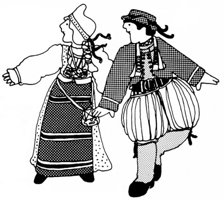 While outlook for the Federation, South, and its member clubs into the new millennium may have looked hazy at first, the future of the international folk dance scene began to look as secure as ever. To further promote international folk dancing, past president Dick Oakes designed and initiated the Federation's website, www.socalfolkdance.org, on November 1, 2002. In November of 2014, Dick was again made webmaster (after ten years of being away from the job) and added several sections, including Albums, Articles, Books, Camps, Dances, ex-Camps, ex-Coffeehouses, ex-Performing Groups, Master Teacher Biographies, Photographs, Resources, Syllabi, and Teachers.
While outlook for the Federation, South, and its member clubs into the new millennium may have looked hazy at first, the future of the international folk dance scene began to look as secure as ever. To further promote international folk dancing, past president Dick Oakes designed and initiated the Federation's website, www.socalfolkdance.org, on November 1, 2002. In November of 2014, Dick was again made webmaster (after ten years of being away from the job) and added several sections, including Albums, Articles, Books, Camps, Dances, ex-Camps, ex-Coffeehouses, ex-Performing Groups, Master Teacher Biographies, Photographs, Resources, Syllabi, and Teachers.
More than 35 groups in nearly the same number of cities were Federation, South member clubs. Although monthly Federation-sponsored festivals are a thing of the past, there were still many held througout the year, as well as several other festivals, workshops, and seminars. Teachers, lecturers, and consultants were listed with the Federation in nearly 75 classifications from 1840s Coloradoan to Vintage Ballroom, plus a section on Local Teachers.
Folk Dance Scene, the official publication of the Federation, South, continued to be published to educate its readers concerning the folk dance, music, costume, customs, lore, and culture of the peoples of the world, as well as to inform people of the opportunities to experience folk dance and culture in Southern California and elsewhere.
Performing groups, both Federation and non-Federation, exhibited the dances of dozens and dozens of the countries of the world at events throughout the Southland and their enthusiasm continues to bring new dancers into the movement.
A new folk dance camp, Fall Camp, was brought to life for the Federation by Marc and Jan Rayman.
Webmaster Dick Oakes transferred much of his phantomranch.net website to the Federation, South, including Marucho's Animated Folk Dance GIFs, many Articles, Kris Marino's Art, a huge amount of Resources, a slew of Folk Dance Camps, nearly all Coffeehouses, his list of Master Teachers, a bunch of Performing Groups, and Southern California Folk Dance Links.
The year 2020 brought the COVID-19 pandemic. People all over the world became more aware of the best practices during a pandemic, from careful hand-washing to social distancing to wearing face covering. The push for the human race to survive the pandemic became the primary concern in the world. The future for the next couple of years became bleak. Some folk dance clubs closed and went to having Zoom meetings instead.
Fall Camp was postponed till the next year (2021) because of the virus. Registered clubs in the Federation, South fell to 22. Non-federation clubs hovered at 19.
One of the oldest folk dance clubs in Southern California, Westwood Co-op, merged with Tuesday Gypsies to form Westside Folk Dancers in 2023 then closed in 2024. On December 31, 2023 Veselo Selo closed its doors.
In 2024, recognizing the need to slow and stop the decline of international folk dancing, the Federation began the Outreach committee with their first meeting in February.
